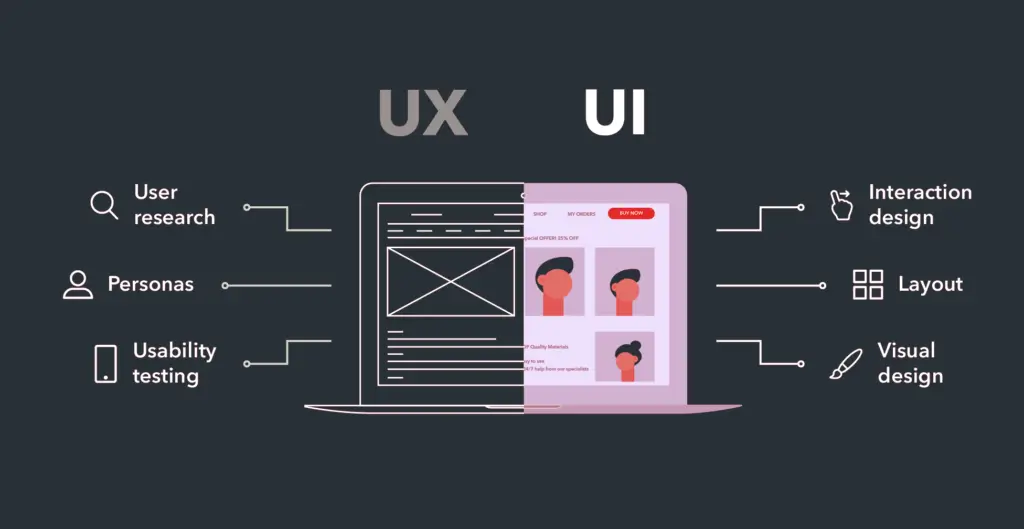Introduction
In the ever-evolving digital landscape, creating user-centric web experiences is paramount. This is where UI-UX principles come into play, forming the foundation of intuitive navigation, visually pleasing interfaces, and engaging user journeys. Join us on a journey through the world of UI-UX principles and discover how to craft web experiences that captivate and convert.
UI vs. UX: Unraveling the Definitions
Catchphrase: "Demystifying UI and UX: Understanding the Key Differences"

Before we delve into the principles, it's crucial to understand the distinction between User Interface (UI) and User Experience (UX) design. These two disciplines work in tandem, but they focus on different aspects of the digital experience.
1. User-Centered Design
Catchphrase: "Putting Users First: The Essence of User-Centered Design"
User-Centered Design (UCD) is the foundation of UI-UX principles. Explore the concept of designing products and interfaces with the end-user in mind, ensuring that every element serves a purpose and enhances usability.
2. Usability and Accessibility
Catchphrase: "Usability and Accessibility: Keys to an Inclusive Experience"
Usability and accessibility are non-negotiable aspects of UI-UX. Learn how to design interfaces that are not only easy to use but also accessible to individuals with disabilities, promoting inclusivity.
3. Visual Hierarchy and Information Architecture
Catchphrase: "Visual Hierarchy: Guiding Users Through Information Architecture"
Visual hierarchy plays a pivotal role in UI-UX design. Discover how to structure content, use typography effectively, and guide users' attention to create a clear and intuitive information architecture.
4. Consistency and Branding
Catchphrase: "Building Trust Through Consistency and Branding"
Consistency in design and branding establishes trust with users. Explore how to maintain a uniform look and feel across your digital properties while conveying your brand's identity effectively.
5. Responsive Design for All Devices
Catchphrase: "Responsive Design: Crafting for Every Device"
As mentioned in a previous post, responsive design is crucial for UI-UX principles. Learn how to ensure that your web interfaces adapt seamlessly to various devices, providing a consistent user experience.
6. Navigation and Wayfinding in UI-UX principles
Catchphrase: "Navigation and Wayfinding: Guiding Users Effectively"
Navigation is a cornerstone of UI-UX principles. Delve into techniques for creating intuitive menus, clear call-to-action buttons, and effective wayfinding elements that help users explore your digital space effortlessly.
7. User Testing and Feedback
Catchphrase: "User Testing and Feedback: Refining the User Experience"
User testing and feedback are invaluable in the UI-UX design process. Explore methods for gathering user insights and using feedback to refine and optimize your designs.
8. Psychology of User Behavior in UI-UX principles
Catchphrase: "Understanding the Psychology Behind User Behavior"
UI-UX principles are deeply rooted in the psychology of user behavior. Gain insights into how users think, make decisions, and interact with digital interfaces to design experiences that resonate.
9. Performance and Loading Times
Catchphrase: "Performance Matters: Minimizing Loading Times"
Performance is a key aspect of user-centric design. Learn techniques for optimizing loading times and ensuring that your web interfaces are swift and responsive.
10. User-Centric Metrics in UI-UX principles
Catchphrase: "Measuring Success with User-Centric Metrics"
To gauge the success of your UI-UX principles, you need the right metrics. Explore key performance indicators (KPIs) and analytics tools that help you track user engagement and satisfaction.
Conclusion: Elevate Your Digital Presence with UI-UX Principles

As we conclude our exploration of UI-UX principles, remember that user-centric design is a continuous journey of learning and improvement. To delve even deeper into the world of web development and UI-UX, continue your educational voyage with our main post, "Mastering Web Development: 10 Essential Concepts for Success." This comprehensive guide provides you with a solid foundation in web development, including the critical aspects of UI-UX that are essential for digital success.
Exploring Advanced UI-UX Techniques
As you advance in your UI-UX design journey, consider these advanced techniques to take your user-centric experiences to the next level:
1. Microinteractions
Microinteractions are subtle animations or feedback mechanisms that enhance user engagement. Learn how to implement them to create delightful user experiences.
2. User Personas and Scenarios
Craft detailed user personas and scenarios to gain a deeper understanding of your target audience. This enables you to design interfaces that cater specifically to their needs and preferences.
3. A/B Testing
A/B testing involves comparing two versions of a web page to determine which performs better. Incorporate A/B testing into your design process to make data-driven decisions.
4. Emotional Design
Emotions play a significant role in user experiences. Explore the concept of emotional design and learn how to evoke specific feelings through your design choices.

5. Storytelling in UX
Storytelling can make your user experiences more engaging and memorable. Discover how to integrate storytelling elements into your interfaces.
6. Gamification
Gamification elements can increase user engagement. Explore how to incorporate game-like features into your designs to make interactions more enjoyable.
7. Multimodal Interfaces
As voice and gesture interfaces become more prevalent, learn how to design multimodal interfaces that work seamlessly across different interaction modes.
8. Ethnographic Research
Ethnographic research involves studying users in their natural environments. Consider conducting ethnographic research to gain deeper insights into user behaviors.
9. UX Writing
Effective UX writing involves crafting clear and concise content that guides users through the interface. Learn the principles of UX writing to enhance user comprehension.
10. Design Systems in UI-UX principles
Design systems provide a structured approach to design, ensuring consistency across all digital properties. Explore how to create and maintain design systems for your projects.
By incorporating these advanced UI-UX techniques into your design process, you can elevate your user-centric experiences to new heights. Remember that UI-UX design is a dynamic field, and staying updated with the latest trends and technologies is essential for continued success.
This comprehensive guide should not only equip you with the knowledge you need but also adhere to SEO best practices, ensuring that your content is not just informative but also discoverable by search engines.
see more Before we delve into the principles, it's crucial to understand the distinction between User Interface (UI) and User Experience (UX) design. These two disciplines work in tandem, but they focus on different aspects of the digital experience.
Before we delve into the principles, it's crucial to understand the distinction between User Interface (UI) and User Experience (UX) design. These two disciplines work in tandem, but they focus on different aspects of the digital experience.
 As we conclude our exploration of UI-UX principles, remember that user-centric design is a continuous journey of learning and improvement. To delve even deeper into the world of web development and UI-UX, continue your educational voyage with our main post, "Mastering Web Development: 10 Essential Concepts for Success." This comprehensive guide provides you with a solid foundation in web development, including the critical aspects of UI-UX that are essential for digital success.
As we conclude our exploration of UI-UX principles, remember that user-centric design is a continuous journey of learning and improvement. To delve even deeper into the world of web development and UI-UX, continue your educational voyage with our main post, "Mastering Web Development: 10 Essential Concepts for Success." This comprehensive guide provides you with a solid foundation in web development, including the critical aspects of UI-UX that are essential for digital success.


